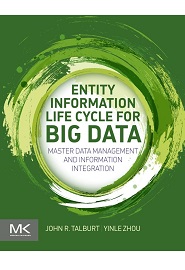
English | 2015 | ISBN: 978-0128005378 | 254 Pages | EPUB, AZW3 | 19 MB
Entity Information Life Cycle for Big Data walks you through the ins and outs of managing entity information so you can successfully achieve master data management (MDM) in the era of big data. This book explains big data’s impact on MDM and the critical role of entity information management system (EIMS) in successful MDM. Expert authors Dr. John R. Talburt and Dr. Yinle Zhou provide a thorough background in the principles of managing the entity information life cycle and provide practical tips and techniques for implementing an EIMS, strategies for exploiting distributed processing to handle big data for EIMS, and examples from real applications. Additional material on the theory of EIIM and methods for assessing and evaluating EIMS performance also make this book appropriate for use as a textbook in courses on entity and identity management, data management, customer relationship management (CRM), and related topics.
- Explains the business value and impact of entity information management system (EIMS) and directly addresses the problem of EIMS design and operation, a critical issue organizations face when implementing MDM systems
- Offers practical guidance to help you design and build an EIM system that will successfully handle big data
- Details how to measure and evaluate entity integrity in MDM systems and explains the principles and processes that comprise EIM
- Provides an understanding of features and functions an EIM system should have that will assist in evaluating commercial EIM systems
- Includes chapter review questions, exercises, tips, and free downloads of demonstrations that use the OYSTER open source EIM system
- Executable code (Java .jar files), control scripts, and synthetic input data illustrate various aspects of CSRUD life cycle such as identity capture, identity update, and assertions
Resolve the captcha to access the links!